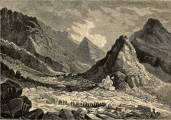


Slate Deposits and Slate Industry of the United
States
Bulletin No. 275 (Page 2)
Only the specific material on the Maine slate quarries will be presented here. You can check to see which sections are included in this document by checking for the links in the Table of Contents. Peggy B. Perazzo)
Merriman's Recent Tests of Certain Maine, New York, Pennsylvania, Vermont, and Virginia Slates.
In view of the incompleteness of published data as to the physical properties of American roofing slates, Doctor Day, chief of the division of mineral statistics of the United States Geological Survey, induced Prof. Mansfield Merriman, of Lehigh University to apply his well-known methods of testing roofing slates to typical specimens from nine important localities. The specimens were obtained from various firms and forwarded to him. Professor Merriman's communication to Doctor Day, containing his full report on the results of these tests, follows:
The following is a report of the results of the tests of thirty-three specimens of roofing slate received at our laboratory from May 6 to May 13, 1905. The tests have been made according to the methods described in my paper on "The strength and weathering qualities of roofing slates," in Transactions of American Society of Civil Engineers, September, 1892.
All the specimens were 12 by 24 inches in size. The following is a statement of the marks placed upon them and of their mean thicknesses:
C1, C2, C3, C4 designate four blue slates from the Chapman Slate Company, Chapman Quarries, Pa., the mean thicknesses being 0.228, 0.204, 0.216, 0.222 inches, respectively.
W1, W2, W3, W4 designate four blue slates from the Williams Slate Company, Arvonia, Va., the mean thicknesses being 0.202, 0.195, 0.206, 0.263 inches, respectively.
P1, P2, P3, P4 designate four blue slates from A. L. Pitts, Arvonia, Va., the mean thicknesses being 0.232, 0.200, 0.204, 0.194 inches, respectively.
B1, B2, B3 designate three blue slates from the Merrill Brownville Slate Company, Brownville, Me., the mean thicknesses being 0.220, 0.195, 0.210 inches, respectively. A fourth piece sent by this firm was accidentally broken.
Mo1, Mo2, Mo3, Mo4 designate four blue slates from Monson Consolidated Slate Company, Monson, Me., their mean thicknesses being 0.238, 0.227, 0.237, 0.225 inches, respectively.
V1, V2 designate two green slates from Vermont Unfading Green Slate Company, Fairhaven, Vt., their mean thicknesses being 0.222, 0.262 inches, respectively Two other pieces sent by this firm were found broken in the package.
R1, R2, R3, R4 designate four green slates from Rising & Nelson Slate Company, West Pawlet, Vt., their mean thicknesses being 0.260, 0.167, 0.224, 0.213 inches, respectively.
M5, M6, M7, M8 designate four green slates from Mathews Consolidated Slate Company, Boston, Mass., their mean thicknesses being 0.194, 0.222, 0.187, 0.205 inches, respectively. The labels on these slates were marked "Quarry N. E."
M1, M2, M3, M4 designate four red slates from Mathews Consolidated Slate Company, Boston, Mass., their mean thicknesses being 0.190, 0.180, 0.174, 0.186 inches, respectively. The labels on these slates were marked "Quarry E."
The following table gives the results of the tests of the above 33 specimens for strength, toughness, density, softness, porosity, and corrodibility, and also the means for each of the nine different kinds of slate:
The given results, with the exception of those for softness, may be compared with the results for Bangor, Pen Argyle, Lehigh, and Peach Bottom slates, given in my papers published in Transactions of American Society of Civil Engineers for September, 1892, and December, 1894, and in Stone for July, 1898. The results above given for softness are comparable with each other, but can not be compared with those in the papers cited; this is due to the circumstance that the former grindstone has been destroyed by fire and that the one selected to replace it has a much smaller abrading capacity.
Mansfield Merriman.
South Bethlehem, PA., July 21, 1905.
Comparative Characteristics of Slates.
The following table shows the principal mineralogical, chemical, and physical characteristics of 38 kinds of slate described by the writer in this bulletin as far as these manifestly bear upon their economic value. These slates are from Arkansas, California, Maine, Maryland, New York, Pennsylvania, Vermont, Virginia, and West Virginia. For full particulars and for scientific details the descriptions should be consulted, by reference to the pages given in the first column. The columns headed "strength" and "toughness" refer to the tests by Merriman, whose methods of experimentation are described on page 47. Microscopic texture refers primarily to the matrix or body of the slate. By "Crystalline" is meant that the matrix consists of interlacing and overlapping scales and fibers of muscovite and is, therefore , a mica-slate or technically a phyllite-slate, although it may inclose unaltered particles of sedimentary origin. Such a slate should have, other things being equal, greater elasticity (toughness) and strength than one in which there is no such texture, or in which it is only incipient. The fineness or coarseness of this crystalline texture probably has a bearing upon the strength and toughness of the slate, but physical data are not sufficient to show this. The coarse-textured Peach Bottom slates, which really approach a mica schist, are the strongest of the twelve kinds of American slates tested, but they are less flexible than all the other kinds tested. In the grade of fissility 1 signifies a perfect slaty cleavage, 4 a very imperfect one. The column of chief mineral constituents includes only the four or five principal ones seen under the microscope, or whose presence has been otherwise determined, and these are given in the descending order of their probable abundance.
To these comparative data should be added the results of a few tests not easily tabulated.
Merriman's later corrosion tests showing the following percentages of loss in weight after immersion in acid solution for 360 hours: Pennsylvania slates, 1.68 to 2.76; Peach Bottom, 1.11 to 1.29; red of New York and Vermont, 0.25. During this test the Pennsylvania slates became a grayish white, some of the Peach Bottom slates change but slightly, others are almost unaffected; the red slates likewise remain almost unaffected.[5]
E. H. S. Bailey's tests of porosity given these indices of porosity: "Hard Vein" Pennsylvania Chapman, 0.11-0.14; Daniels quarry, 0.14; Belfast quarry, 0.25; red of New York and Vermont, 0.21.[6]
J. F. Williams's tests of the compression of columns of slate 10 inches long by a inch in section with the cleavage vertical, show that the purplish of the unfading green series of Vermont stands 20,000 pounds; the unfading green, 16,020 pounds, and the red of New York and Vermont, 17,730 pounds.[7]
The following results of various tests of Maine (Monson) slate made at the United States Arsenal at Watertown, Mass., were republished from the War Department reports in the Twentieth Annual Report of the United States Geological Survey, Part VI (continued), 1899, p. 395:

Comparitive Characteristcs of Various Slates
Comparative characteristics of various slates. (The following quarries are listed: Mena, Polk, Company, Arkansas; Mammoth Red and Lost Hannah, Polk County, Arkansas; Mammoth Red, Polk County "Arkansas; Southwest Slate Manufacturing Co., Polk County, Arkansas; Eureka Quarry, El Dorado County, California; Merrill Quarry, Brownville, Maine; North Blanchard Quarry, Brownville, Maine; Monson Pond Quarry, Monson, Maine; Maine Slate Co. of Monson, Maine; West Monson Quarry, Monson, Maine; Thurston Quarry, Maryland; Granville and Hampton Quarry, New York; Old Bangor Quarry, Northamton County, Pennsylvania; North Bangor Quarry, Northampton County, Pennsylvania; Albion Quarry, Pen Argyle, Pennsylvania; Albion, Gray Bed Quarry, Albion, Pennsylvania; Heimbach, Big Bed Quarry, Northampton County, Pennsylvania; Heimbach, Black Bed Quarry, Pennsylvania; East Bangor Consolidated Quarry, Northampton County, Pennsylvania; Slatington, Lehigh County, Pennsylvania; Chapman "hard vein" Quarry, Pennsylvania; Peach Bottom Quarry, Pennsylvania and Maryland; Northfield, Vermont Black Slate Co. Quarry, Northfield, Vermont; "Sea Green" Quarry, Vermont; Purplish of "Sea Green" Quarry; Vermont; "Unfading Green" Quarry, Vermont; Purplish of "Unfading" slate, Vermont; Benson (prospect), Vermont; Arvonia, Williams Quarry; Arvonia, Virginia; Arvonia, Fontaine Quarry, Arvonia, Virginia; Bremo (prospect), Virginia; Snowden Quarry, Virginia; Martinsburg Quarry, West Virginia.)
| Pounds. | ||
| Maximum fiber stress per square inch | 7,671 | |
| Shearing test per square inch | 2,192 | |
| Ultimate compressive strength per square inch | 19,510 | |
| Coefficient of expansion, 0.000005. | ||
The relative commercial value of several slates is an index of their physical characteristics. Mathews, in 1898, gave these prices for slates 14 by 7 inches, three-sixteenths thick, per square: Peach Bottom, $4.85; Northampton County, Pa., $3.50; Lehigh County, Pa., $3.40-$3.95; Maine (No. 1), $6.40; Arvonia, Va., $3.60; unfading green, Vermont, $4.50; red, New York, $11.[8]
The following prices per square for slates, No. 1 quality, 16 by 8 inches, f.o.b., were obtained by Doctor Day from producers for January, 1905: Peach Bottom, $6.35; Monson, Me., $7.20; red, New York, $11; Bangor, Pa., $5.75; Albion, Pa., $5; Pen Argyle, Pa., $4.75; Chapman, Pa., hard vein, $5.25; Slatington, Pa., $4.50 to $5; unfading green, Vermont, $4.50 to $5.25; sea green, Vermont, $3.50; Virginia, $5 to $5.50.
In accordance with the scheme of classification of slates given on page 6, most of the slates whose characteristics are given on the preceding table are here arranged systematically:
Statistics of Production, Imports, and Exports.
By A. T. Coons.
Production.
Although slate has been known and quarried in this country, more or less, since 1750, when we find records of its use in Massachusetts, Maryland, and Pennsylvania, and since about 1850 in New York, Vermont, Georgia, California, Virginia, and other States, no statistics of production for the entire United States are obtainable for any year preceding 1879.
For the years 1879, 1881, 1882, and 1883 the production is largely estimated. The statistics for 1880 are taken from the Tenth Census and are very accurate. The figures from 1884 to 1888 are fairly reliable, and from 1889, when the figures are those of the Eleventh Census, to the present time, the data as to production have been obtained indirectly from the slate quarries, and are as accurate as can be procured. There is no record of production in New York from 1884 to 1890, but the operations in this State being closely allied to those of Vermont the output is doubtless included in that of Vermont.
The following tables give the output of slate in the United States from 1879 to 1904, by States, showing, as nearly as possible, the number of squares of roofing slate produced, their value, and the value of slate used for other purposes, as far as figures are obtainable:
| Production of Slate in the United States from 1879 to 1904 | |
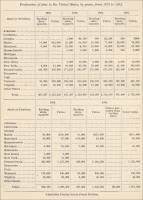
|

|
| 1879-1884 | 1885-1889 |

|

|
| 1891-1894 | 1895-1898 |
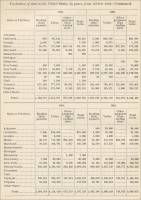
|

|
| 1899-1902 | 1903-1904 |
The following table shows the number of squares and value of roofing slate, average value per square, and value of milled stock, by years, from 1879-1904, inclusive:
As will be seen from the above tables, the values from 1879 to 1889 do not represent the entire value of slate quarried, as no record of slate used for mantels, school slates, pencils, tombstones, etc., was kept. In 1885 there was a large decrease in the average value per square compared with 1884-from $3.83 in 1884 to $3.05 in 1885. From 1885 to 1892 both the price and production increased in value, but owing to the financial troubles of 1893 the output decreased considerably, or from a total value of $4,117,125 in 1892 to $2,523,173 in 1893. Since that time the value of the output has steadily increased, being aided largely since 1896 by export trade, until in 1903 the value of the output was $6,256,885, the greatest yet obtained. In 1903, however, while the beginning of the year showed active operations in the slate industry, the latter part of the year showed a very decreased demand, due to strikes in the building trades. Several of the chief producing States showed decreased output of roofing slates, with increased price. this is shown in the increase of average price from$3.45 per square in 1902 to $3.88 in 1903, and by a decrease of 56,974 squares-from 1,435,168 squares in 1902 to 1,378,194 squares in 1903-while the value increased from $4,950,428 in 1902 to $5,345,078 in 1903, a gain of $394,650. In 1904 the beginning of the year showed the same unsettled state, with less demand and slightly lower price, the total value of roofing slate decreasing $675,789 in 1904, or from $5,345,078 in 1903 to $4,669,289 in 1904. The number of squares also decreased from 1,378,194 squares in 1903 to 1,233,757 squares in 1904, or 144,437 squares. The value of mill stock has steadily increased, the demand being continually increased by the increased use for which this class of slate is continually demanded.
Imports and Exports.
Imports.
The importation of slate into this country has never assumed very great proportions, and the largest quantity was of course imported before the slate quarries of the United States were fairly developed and in running order. The following tables, taken from the reports of the Bureau of Statistics, Department of Commerce and Labor, show the value of roofing slate and other slate, chiefly slate mantels, chimney pieces, etc., by fiscal years ending June 31 from 1867 to 1904. From 1867 to 1875 the total value per annum amounted to somewhat over $100,000, the value of the roofing slate averaging two-thirds of the whole. In 1875 there was a decided drop in the value of roofing slate imported, and since that time the imports of roofing slate have amounted to practically nothing. In the last twenty years the annual value of all imported slate has decreased from $50,739 in 1884 to $9,436 in 1904.
The following table shows the value of roofing and other slates imported and entered for consumption in the United States, by fiscal years ending June 30, from 1867 to 1904, inclusive:
| Value of roofing and other slate imported and entered for consumption in the United States, 1867 to 1904, inclusive | |

|

|
| 1867-1882 | 1883-1904 |
Exports.
Almost from the beginning of the slate-quarrying industry in the United States slate has contributed to the export movement of this country. In 1876, 1877, 1878, and again in 1880 a large quantity of slate was exported, the greatest part going to Great Britain and the Continent, a remarkable feature being that several cargoes were shipped directly to Welsh ports, the base of the slate supply for Great Britain. From that time until 1896 Great Britain did not take much of the product, which found an outlet in South America, the West Indies, and Australia. In fact, British Australasia has always been one of the largest foreign consumers of American slate. Until 1884 no general record of the export movement was obtainable, but as probably 90 per cent was shipped from the port of New York, the following table is given, showing the shipment of slate from that port from 1876 to 1888. The export of manufactured slate is also shown in this table, and is almost entirely the value of school slates.

Value of exports of roofing and other slate
from the port of New York from 1876 to 1888, inclusive.
Since 1884 the Bureau of Statistics, Department of Commerce and Labor, has shown by ports and custom districts the value of the roofing slate exported by fiscal years ending June 30, and these figures are given in the following table. No separate record has been kept of the manufactured product.
|
Exports of slate from the United States, showing ports and customs districts from which and to which sent, in the fiscal years 1884-1904. |
|
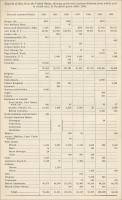
|
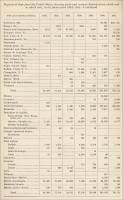
|
| 1884-1890 | 1891-1897 |

|

|
| 1898-1904 | 1898-1904 (cont.) |
It will be seen that the value of roofing slate exported decreased for $377,233 in 1876 and $646,272 in 1877 to $37,195 in 1894 and $38,806 in 1895. In 1896, however, owing to strikes in the Welsh quarries, the United States gained a foothold again in England and in the English colonies. The value of slate exported in 1896 was $266,385; in 1897, $780,112, and the greatest valuation was reached in 1899, when the figures were $1,363,617. The value of the exported slate in 1904 was $726,715, showing that, although the strikes are practically over, the demand for American slate remains. However, in the last two years French slates of a small size have found considerable market in England at less price than American slates. Great Britain and Ireland, British Australasia, the Dominion of Canada, and Denmark are, in the order named, the largest receivers of American slate.
Bibliography of Slate.
Special Scientific Papers and Memoirs (relating to Maine).
Bayley (W. S.). Slate from Monson, Piscataquis County, Maine. (Bull. U. S. Geol. Survey No. 150. The educational series of rock specimens collected and distributed by the U. S. Geological survey, 1898, pp. 308-313.
Works of an Economic Character (relating to Maine).
Dale (T. Nelson). Slate in Maine, Pennsylvania, Vermont (northern), Virginia, and West Virginia. Bur. U. S. Geol. Survey, No. 260. Contributions to economic Geology, 1904-1905, pp. 486-488.
Hitchcock (Charles H.). Roofing slate in Maine. Preliminary Rept. Nat. Hist. and Geol., State of Maine, pp. 316-319, 1861.
Hitchcock (Charles H.). Roofing slate in Piscataquis and Penobscot counties, Me. Second Ann. Rept. Nat. Hist. and Geol., Maine, pt. 2, Geology. Monson, p. 280; Shirley, p. 282; Paten, p. 360, 1862.
Jackson (C. T.). On the Waterville, Me., slates. Am. Jour. Science, vol. 41, p. 163, 164, 1841; also Trans. Assoc. Am. Geol., p. 16, 1843.
[1] Ibid., page 61, footnote a: See Hitchcock, C. H. The geology of northern New England, 1886; also his preliminary Rept. Nat. Hist. and Geol., Maine, including geological map of northern Maine, pt. 1, 1861, pp. 316, 319, and Second Ann. Rept., 1862, pt. 2, pp. 280, 282, 360.
[2] Ibid., page 63, footnote a: See Bailey, W. S., Bull. U. S. Geol. Survey No. 150, 1898, p. 313, and Twentieth Ann. Rept., Pt. VI (Cont.), 1899, p. 394.
[3] Ibid., page 65, footnote a: Measurements obtained through the courtesy of C. H. Dunning, Supt.
[4] Ibid., page 67, footnote a: See note on a new variety of Maine slate in Bull. U. S. Geol. Survey No. 285.
[5] Ibid., page 124, footnote a: Trans. Am. Soc. Civ. Eng., vol. 32, p. 538.
[6] Ibid., page 124, footnote b: Loc. cit., p. 542.
[7] Ibid., page 124, footnote c: Loc. cit., p. 132 (see Bibliography, p. 145 of this bulletin).
[8] Ibid., page 125, footnote a: Maryland Geol. Survey, vol. 2, p. 240.
Commercial use of material within this site is strictly prohibited. It is not to be captured, reworked, and placed inside another web site ©. All rights reserved. Peggy B. and George (Pat) Perazzo.


